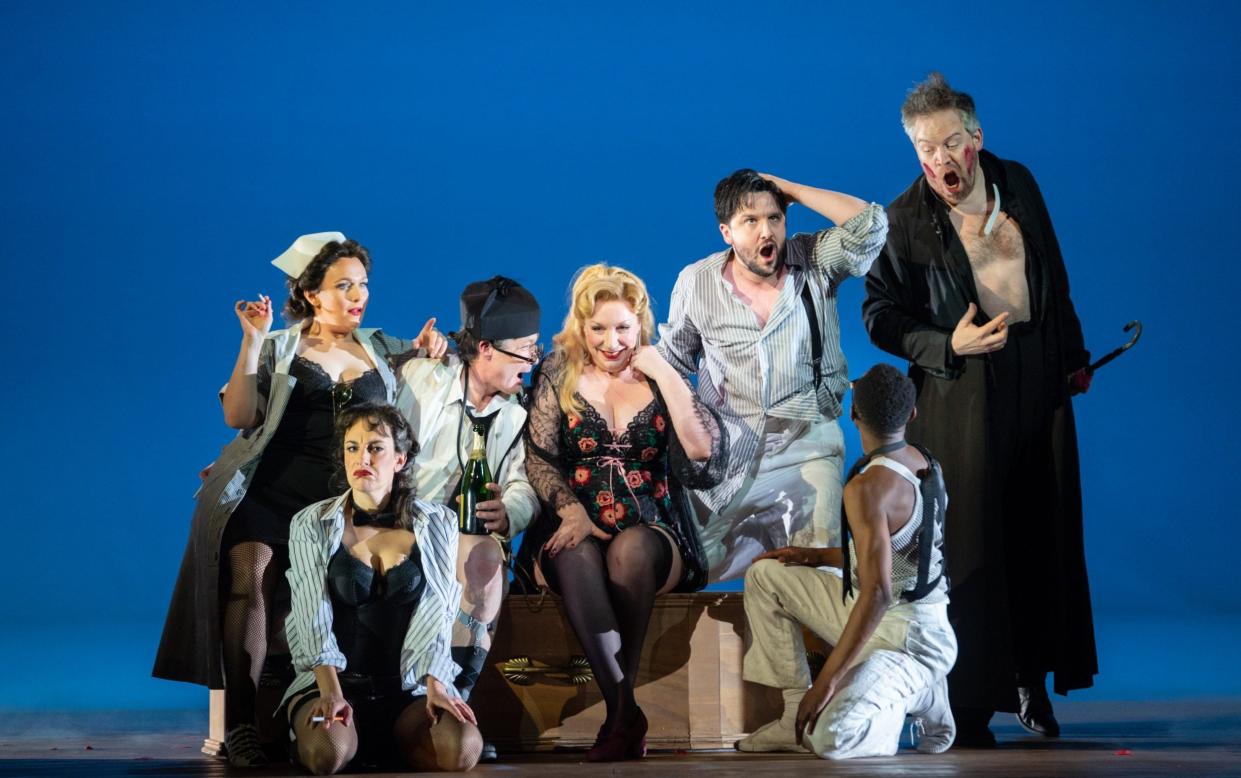The Dead City: a wild whirl of murder, lust and deranged grief

- Oops!Something went wrong.Please try again later.
Red roses fill the antiseptic museum-like room in which Paul memorialises his dead wife, Marie. No other colour is allowed: children bearing yellow roses are shooed out of the room. A braid of Marie’s hair hangs framed above the fireplace, her dress, shawl and shoes on display. Shafts of light obtrude only when a door opens.
This is the eerie setting by Miriam Buether for Erich Wolfgang Korngold’s luridly expressionistic opera, first performed in 1920 (but which only reached the UK in a concert performance in 1996), in Annilese Miskimmon’s highly effective new production for English National Opera. We share Paul’s obsessive love for his lost wife, so intense that it becomes focused on the dancer Mariette, who somehow reminds him of Marie. (“Somehow”, because here the supposed physical resemblance between Lauren Bridle’s Marie and Allison Oakes’s Marietta was entirely missing.) Paul starts to hallucinate as he becomes embroiled with this new woman – to the point that he eventually strangles her with that braid of Marie’s hair. But suddenly we return to the opening of the opera, with Mariette still alive, upon which Paul bids her farewell: his dark dream has purged his obsession with the past.
The story, taken from Georges Rodenbach’s 1892 novel Bruges-la-Morte – which also, indirectly, inspired Hitchcock’s Vertigo – is set in Bruges, so Kelley Rourke has provided a new English version, rather plain but very clear. Miskimmon atmospherically conjures the misty, impenetrable rituals of the dead city, as the back wall of Paul’s room rises to reveal the foggy processions of Marie’s funeral. The ceiling lights evaporate to reveal first Mariette, and then Marie on her coffin, floating above the action.
The Dead City stretches the resources of the company and its cast to the limit. The vast orchestra is admirably controlled by Kirill Karabits, who injects energy into Korngold’s chromatically wandering score, and does not linger except in a couple of the emotional set-piece numbers (where an evocative lute-song, for instance, now becomes an LP on the gramophone). Running the first two acts of the opera together makes for an over-extended first half, but it allows dramatic use of Korngold’s voluptuous orchestral interludes to restage Marie’s death.
The demands on the two lead singers, too, are intense. Here, both were making their ENO debuts: we were told that Rolf Romei (Paul) had been ill, but the occasional crack in the voice served only to heighten the constant emotion of his tortured, wiry frame, superbly acted. Oakes is a large-scale, highly dramatic soprano, confidently soaring over the orchestra, if not always focusing on Mariette's coquettish nature. Elsewhere, there is magnificent singing from Audun Iversen as Paul’s friend Franz, and especially subtle acting from Sarah Connolly as Paul’s protective housekeeper Brigitta. Appearing in the dream sequence through an open fireplace, a children’s chorus adds religious echoes to a remarkable period-piece of Freudian drama.
What this superb piece of company work on the largest scale decisively demonstrates, once again, is that ENO, while fulfilling the Arts Council’s admirable brief to diversify its work out of London, both needs and deserves to retain its company base at the Coliseum for its adventurous, open-minded audience. It is time for the Arts Council to agree to this.
Until April 8. Tickets: 020 7845 9300; eno.org
